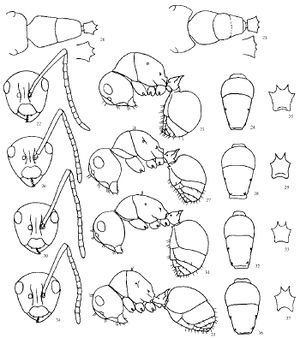Key to Polyrhachis Cyrtomyrma of China and the Indo-China Peninsula
This worker key is based on: Xu, Z.-H. 2002b. A systematic study on the ant subgenus Cyrtomyrma Forel of the genus Polyrhachis Smith of China (Hymenoptera: Formicidae). Acta Entomol. Sin. 45: 522-530
You may also be interested in:
1
- Shoulders of pronotum form a pair of acute or right angles . . . . . 2
- Shoulders of pronotum roundly prominent or rounded . . . . . 6
2
return to couplet #1
- Propodeum with a pair of small denticles. Petiolar node with only a pair of long lateral spines (Figs. 1- 4) (China: Yunnan) . . . . . Polyrhachis cornihumera
- Propodeum unarmed . . . . . 3
3
return to couplet #2
- Shoulders of pronotum form a pair of acute angles. Petiolar node with only a pair of laterodorsally pointed short lateral spines (Figs. 5-8) (China: Yunnan) . . . . . Polyrhachis dentihumera
- Shoulders of pronotum form a pair of right angles . . . . . 4
4
return to couplet #3
- Petiolar node with a pair of laterally pointed elongate lateral teeth, median teeth very blunt and indistinct (Figs. 9-10) (Cambodia) . . . . . Polyrhachis jurii
- Petiolar node with a pair of subtriangular short lateral teeth, median teeth minute but distinct . . . . . 5
5
return to couplet #4
- Body surface smooth and shiny. Legs red. TL 5.3 mm (Fig. 11) (Burma; India: Bangladesh: Thailand: Indonesia) . . . . . Polyrhachis laevissima
- Body surface punctured and dull. Legs black. TL 6.5-7.0 mm (Laos) . . . . . Polyrhachis vitalisi
6
return to couplet #1
- Propodeum armed with a pair of small denticles . . . . . 7
- Propodeum unarmed . . . . . 9
7
return to couplet #6
- Median teeth of petiolar node with a combined elongate base (Fig. 12) (China: Guangdong: Vietnam) . . . . . Polyrhachis demangei
- Median teeth of petiolar node without a combined elongate base . . . . . 8
8
return to couplet #7
- Propodeal teeth short and minute. Legs red. TL 4.7 ~ 5.5 mm (Figs. 13-16) (China: Yunnan) . . . . . Polyrhachis cyphonota
- Propodeal teeth elongate and slender. Legs blackish brown. TL 5.8-7.3 mm (Figs. 17-19) (China: Guangdong, Guangxi and Hainan; New Guinea) . . . . . Polyrhachis debilis
9
return to couplet #6
- Shoulders of pronotum roundly prominent. Legs blackish brown. TL 4.4 mm (Fig. 20) (Burma) . . . . . Polyrhachis burmanensis
- Shoulders of pronotum rounded. Legs red or black. TL 4.8-6.2 mm . . . . . 10
10
return to couplet #9
- Legs red . . . . . 11
- Legs black . . . . . 12
11
return to couplet #10
- Body surface smooth and shiny. Femora and tibiae blood- red. Petiolar node with 4 subequal teeth ( Figs. 21 - 25) ( China: Yunnan, Guizhou, Hubei, Hunan, Zhejiang, Jiangxi, Fujian, Taiwan and Hainan: Burma; Thailand: India: Sri Lanka: Indonesia: New Guinea; Australia) . . . . . Polyrhachis rastellata
- Body surface densely, superficially and finely punctured, less shiny. Petiolar node with median teeth distinctly longer than lateral ones. Femora brownish red, tibiae blackish brown (Figs. 26 - 29) (China: Yunnan) . . . . . Polyrhachis orbihumera
12
return to couplet #10
- Body surface smooth and shiny, with blackish-blue metallic luster (Figs. 30 - 33) ( China: Yunnan) . . . . . Polyrhachis rotoccipita
- Body surface densely and finely punctured, dull, without metallic luster (Figs. 34-37) (China: Yunnan) . . . . . Polyrhachis brevicorpa

